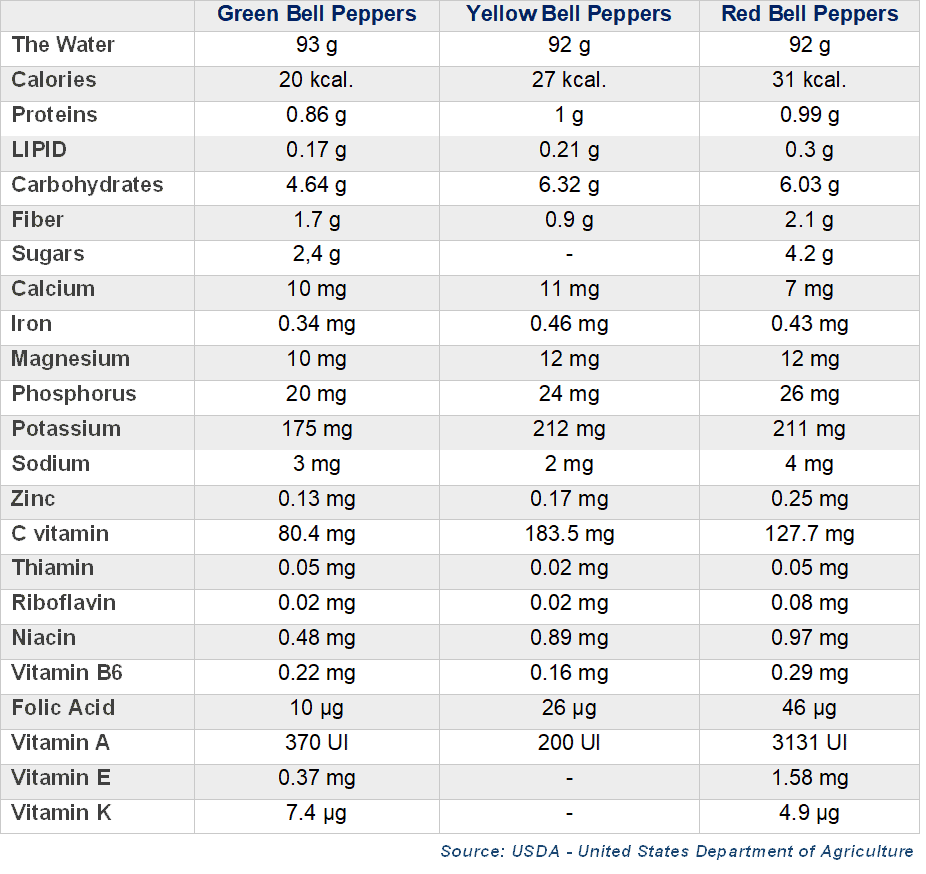Pepper (capsicum annuum) is a species that belongs to the Solanaceae family, the same botanical family as hot peppers, tomatoes, eggplants. Bell pepper is a vegetable that can be eaten raw or cooked. There are four main types of peppers: bell peppers, hot peppers, long peppers (kapia), and donuts.
Peppers are low in calories but with beneficial properties for the body due to their rich nutrient content. Compared to hot peppers, they are sweet and have a much lower number of spicy substances, in some cases not at all.
NUTRITIONAL COMPOSITION OF BELL PEPPERS
Bell peppers contain about 92% carbohydrates, low amounts of protein and fat. Carbohydrates are mainly sugar responsible for the sweet taste of peppers.
Bell peppers are a cocktail of vitamins and minerals, especially vitamin C. An average bell pepper contains 169% of the recommended daily dose of vitamin C. It also contains vitamin B6 (pyridoxine), potassium, folic acid, vitamin E and vitamin A, etc. The main phytonutrients in bell peppers are Capsantine, a potent antioxidant responsible for the intense red color of red peppers; Violaxanthin, the most common antioxidant in orange peppers; Lutein which abounds in green bell peppers, being diminished later after the peppers ripen; Quercetin, a polyphenol with antioxidant properties; Luteolin which is similar to quercetin and has an antioxidant role. The aroma of peppers is given by pyrazine (2-methoxy-3-isobutylpyrazine) and other volatile compounds, such as beta-ionones, 2,6-nonadienal and hexenal. Bell peppers contain a small number of alkaloids that provide a spicy taste, namely capsaicin.
Contrary to popular belief, pepper seeds are not a source of capsaicin. The capsaicin-producing glands are inside the soft membrane at the base of the spine. In the presence of an increased amount of capsaicin in the glands, it migrates to the surrounding areas, spreading to the seeds and the rest of the pepper.
BELL PEPPERS COLOR DIFFERENCES
The type of peppers and the harvest period influence their color, taste, and aroma. Peppers go through specific processes during the ripening period, during which their chemical composition changes.
Green peppers contain a much higher amount of chlorophyll and have a fresh smell due to aldehydes. The orange ones have lutein, violaxanthin and beta-carotene, chemical compounds responsible for the specific color, the same as for carrots. Red pepper produces more E-2-hexenal and E-2-hexanol, which also gives it a sweet fruity aroma. Carotenoid pigments in red pepper include capsanthin and capsorubin.
Here is the nutritional composition of bell peppers by color:

HEALTH BENEFITS OF ORANGE BELL PEPPERS
Like most vegetables, bell peppers have beneficial properties for health, being considered healthy foods. They are associated with a reduced risk of disease due to their nutrient content. The following highlights the main health benefits of bell peppers.
Antioxident Properties
Bell peppers are an essential source of vitamin C and vitamin E, with an antioxidant role. The list of antioxidant phytonutrients in bell peppers also includes flavonoids (luteolin, quercetin, hesperidin), carotenoids (alpha-carotene, beta-carotene, cryptoxanthin, lutein, zeaxanthin), hydroxycinnamic acids (ferulic acid and cinnamic acid).
Antioxidant compounds can reduce the risk of some diseases, from cardiovascular disease to diabetes. A meta-analysis published in the Pakistan Journal of Food Sciences shows that bell peppers are an important source of antioxidants, especially due to ascorbic acid (vitamin C), a 100 g serving of peppers providing more than 100% of the daily dose (recommended 65 to 90 mg/day). And the carotenoids that give the orange color have antioxidant effects on the body.
Also, research published in the Journal of the Science of Food and Agriculture shows that organic peppers contain a higher amount of antioxidants than those in conventional crops. The research results showed that peppers from organic crops had a higher level of bioactive compounds (carotenoids and polyphenols) and vitamin C than peppers grown by traditional methods.
Possible Anticancer Effects
Bell peppers are rich in sulfur compounds and enzymes (S-conjugated cysteine beta-lyase) that promote the production of these sulfur compounds. These enzymes also appear to have anti-cancer effects.
Apigenin is a sweet pepper flavonoid that can inhibit the growth of cancer cells, especially breast cells, according to a review of studies in this regard. Lycopene and beta-carotene, very rich in orange bell peppers, have an antioxidant role and can help reduce cancer risk. Carotenoids could also reduce cancer risk by reducing free radicals in the body, responsible for many diseases.
Fosters Eye Health
Nutrition plays a crucial role in maintaining healthy eyesight and preventing conditions such as macular degeneration or cataracts. Lutein and zeaxanthin are carotenoids found especially in orange bell peppers, improving eye health after proper consumption.
A 100g serving of orange bell pepper has 3131 IU or 101% of the recommended daily vitamin A dose. It also contains antioxidant flavonoids such as carotene, lutein, zeaxanthin, and cryptoxanthin. Together, these antioxidants protect the body from the effects of harmful free radicals.
According to a study published in the journal Nutrients, dietary sources of lutein can lead to maintaining and restoring vision health. These are pigments found in the retina and protect the eyes from damage caused by blue light, improve visual acuity and help reduce reactive oxygen species.
Reduces the Risk of Anemia
Bell peppers are not only an essential source of iron but also of vitamin C. Thus, they can help reduce anemia, a disease characterized by a reduction in the blood’s ability to carry oxygen. The main cause of anemia is iron deficiency, the main symptom being weakness and fatigue. On average, bell pepper contains 169% of the recommended daily allowance of vitamin C.
DO BELL PEPPERS HELP YOU LOSE WEIGHT?
Bell peppers contain 31 calories per 100 grams. 24.3 of these calories come from carbohydrates (6.3g per 100 grams of which 2.1g fiber). This would be a good reason to include bell peppers in your diet. The amount of calories in bell peppers is low compared to many other vegetables to help you lose weight, helping you feel fuller without adding too many calories to your diet. This can help you eat fewer high-calorie foods.
Consumption of enough vitamins and minerals is essential for both short-term health and weight loss. Bell peppers can help you reach your daily vitamin and mineral goals to some extent, but you will also need other foods. This means that it is good to eat bell peppers daily, but you will also need a balanced diet.
HEALTH RISKS OF BELL PEPPER CONSUMPTION
Peppers can rarely cause allergies. Allergies caused by bell peppers are rare. Most are cross-reactions and mainly occur in people with severe pollen allergies.
Hot peppers can be irritating. The level of hot agents in bell peppers tends to zero, but some peppers may contain a noticeable or higher amount of capsaicin so that consumption can be felt hot and can cause irritation to the mouth and throat. Capsaicin can cause inflammation on contact with the mucous membranes of the oral cavity, throat, or stomach and a burning sensation.
Consumption of milk or yogurt, at room temperature or colder, can lessen this sensation. Avoid contaminating your fingers with hot pepper to avoid later contamination of the nose, eyes, or other sensitive areas.
STORAGE AND CONSUMPTION
Bell peppers must have a uniform color, be firm, uncut, without spots or soft areas. For consumption, the seeds, the spine, and the inner membrane that houses the seeds are removed. Therefore, the pepper is usually cut in half or quarters.
They can be eaten in salads, cooked in various dishes with vegetables, meat or fish, and baked after baking and removing the burned membrane. After baking, to facilitate the peeling process put them in plastic bags or cover with a lid for a few minutes.
Store in the refrigerator in plastic or paper bags, and can last up to 3-4 days. Prolonged or high-temperature cooking reduces the number of phytonutrients, especially luteolin. For example, after steaming for 7-8 minutes at 150 °C, the number of phytonutrients is reduced by 40%.
Key TAKEAWAYS
Orange bell peppers contain almost twice as much vitamin C as green peppers.
Thanks to their high content of vitamin C, yellow bell peppers can reduce the risk of anemia.
Lutein and zeaxanthin carotenoids are essential for eye health.
Carotenoid pigments in orange bell peppers have antioxidant and anti-inflammatory properties, thus reducing the risk of cancer. Orange bell pepper has a low-calorie content and is thus a vegetable indicated in diets for weight loss. Orange bell peppers are safe, only hot peppers can cause irritation. Yet it is worth to always consult your doctor or medical professional before making any changes to your diet.
Article Sources
HealthxTips is committed to delivering content that adheres to highest standard for accuracy, sourcing and objective analysis.
HealthxTips uses only high-quality and trustworthy sources to support the facts in our articles.
1. Abdel-Aal, E.-S., Akhtar, H., Zaheer, K., & Ali, R. (2013). Dietary Sources of Lutein and Zeaxanthin Carotenoids and Their Role in Eye Health. Nutrients, 5(4), 1169–1185. doi:10.3390/nu5041169
2. Abu-Zahra T. R. (2011). Influence of agricultural practices on fruit quality of bell pepper. Pakistan journal of biological sciences : PJBS, 14(18), 876–881. https://doi.org/10.3923/pjbs.2011.876.881
3. Black, H. S., Boehm, F., Edge, R., & Truscott, T. G. (2020). The Benefits and Risks of Certain Dietary Carotenoids that Exhibit both Anti- and Pro-Oxidative Mechanisms-A Comprehensive Review. Antioxidants (Basel, Switzerland), 9(3), 264. https://doi.org/10.3390/antiox9030264
4. Bode, A. M., & Dong, Z. (2011). The two faces of capsaicin. Cancer research, 71(8), 2809–2814. https://doi.org/10.1158/0008-5472.CAN-10-3756
5. Hallmann, E., & Rembiałkowska, E. (2012). Characterisation of antioxidant compounds in sweet bell pepper (Capsicum annuum L.) under organic and conventional growing systems. Journal of the science of food and agriculture, 92(12), 2409–2415. https://doi.org/10.1002/jsfa.5624
6. The biochemistry of peppers :: ChemViews magazine :: ChemistryViews. (n.d.). https://www.chemistryviews.org/details/ezine/6108461/The_Biochemistry_of_Peppers.html








0 Comments